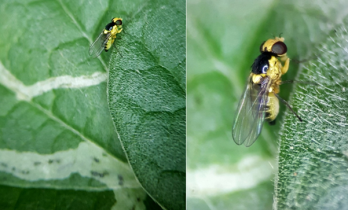Exotic leaf miners
Exotic polyphagous leaf mining flies (Liriomyza spp.) feed on a wide range of vegetable crops, posing a serious threat to agricultural and horticultural industries.
Background
There are more than 300 species of leaf miners worldwide, with many species already present in Australia, including some that are native.
Not all miners affect horticultural production, with only 5 exotic species considered significant pests. Confirmed pest species in Australia include:
- Liriomyza sativae (vegetable leafminer) – detected in Torres Strait and Northern Peninsula Area of Queensland in 2015, under official control
- Liriomyza huidobrensis (serpentine leaf miner) – exotic species established in Victoria, New South Wales and Queensland since 2020
- Liriomyza trifolii (American serpentine leafminer) – established in Torres Strait, northern peninsula area of Queensland, and northern Western Australia since 2021.
The following species are not present in Australia:
- Liriomyza bryoniae (tomato leafminer)
- Liriomyza cicerina (chickpea leafminer).
Damage from local species is similar to that caused by exotic leaf miners, so any suspect signs should be reported.
Impacts
The insects feed on common weeds in the Asteraceae (sow thistle) and Solanaceae (nightshade) and Fabaceae families. Vegetable crop hosts include beans, cabbage, capsicum, chili, celery, cucumber, eggplant, lettuce, nursery plants, onions, peas, potatoes, and tomatoes.
Damage from their feeding reduces the plants' ability to photosynthesise, resulting in premature leaf drop or death. Heavy infestations can also leave stippling damage on plants from the egg laying sites. This can reduce crop yield, making leafy green crops unfit for market.
Leaf miners spread through the movement of:
- live host plants containing eggs, larvae, or adults
- contaminated soil or potting mix holding pupae.
Adult leaf miners only fly short distances between crops, but they can travel further by attaching to humans or through wind dispersal.
Identification
Leaf miners feed in tunnels under the leaf surface, causing visible damage as squiggly white lines, referred to as mines.
Both exotic and local species of the adult flies look similar and must be identified via microscope examination. They are 1 to 3mm long, grey-black flies with yellow markings.
The larvae of leaf miners are yellow to white in colour.
Lifecycle
Several generations can be produced during a year. Female flies pierce the leaf surface to lay eggs inside, which hatch in 2 to 5 days depending on temperature.
Larvae mine the leaf tissue on which the eggs are laid. They leave the plant to grow into pupae on the leaf surface or in the soil. The entire life cycle can be as short as 2 weeks.


